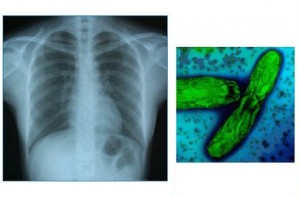The risk of TB diagnosis is significantly increased in women during the first 6 months after pregnancy, according to a new UK-wide study published in the American Journal of Respiratory and Critical Care Medicine.
 |
| [relatedPosts title=”Related Posts”] |
|
|
In a joint study between scientists at the Health Protection Agency (HPA) and the University of East Anglia, researchers analysed data on all women with pregnancies between 1996 and 2008 from the General Practice Research Database.
A total of 192,801 women who had a total of 264,136 pregnancies were included in the study and over the 12 year period of study there were 177 TB cases among this group.
After adjusting for age, region and socio-economic status, post natal women had a significantly higher TB risk outside pregnancy, whereas no significant increase during pregnancy was observed. Overall the researchers calculated that the rate of TB among pregnant and post natal women was 15.4 per 100,000 people, which is significantly higher than the rate outside of pregnancy – 9.1 per 100,000.
Study author Dr Dominik Zenner, a consultant in public health at the HPA, said: “The aim of this study was to establish whether pregnancy increases the risk of TB and this was the first primary care based study to quantify the risk of TB during pregnancy and post pregnancy. Although we found a significantly increased risk of TB in the six months following pregnancy, but not during pregnancy, the risk during pregnancy is nonetheless likely to be increased. This is in keeping with the observation that pregnant women are disproportionally affected by other respiratory illnesses such as flu.
“The reason why more post natal women were diagnosed with TB than pregnant women could be because the TB infection wasn’t picked up during pregnancy. We hope these findings will encourage those looking after pregnant women to consider possible TB infection in women presenting with symptoms to avoid delays in diagnosis.”
Lead author Ibrahim Abubakar, head of TB surveillance at the HPA and Professor of infectious disease epidemiology at the University of East Anglia said: “This study clearly shows that future guidance to healthcare workers, especially midwives and health visitors, should take into account that the risk of TB may be increased during pregnancy or shortly after giving birth.
“Those looking after pregnant and post natal women should be encouraged to look out for the signs and symptoms of the disease, particularly among women in high risk groups such as immigrants from countries with a high burden of TB, as early diagnosis and appropriate treatment is essential. TB is a preventable and treatable condition but, if left untreated, can be life threatening.”
Latest HPA figures found a total of 8,483 new cases of TB were reported in the UK in 2010.TB is an infection caused by bacteria and often affects the lungs. It is spread from person to person when one who has TB of the lungs coughs or sneezes. Only some people with TB in the lungs are infectious to other people and even then, you need close and prolonged contact with them to be at risk of being infected. Any of the following symptoms may suggest TB: – Fever and night sweats; Persistent cough; Losing weight; Blood in your sputum (phlegm or spit).
Further Information
- Zenner, D. et al. 2011. Risk of tuberculosis in pregnancy: A national, primary care based cohort and self-controlled case series study. American Journal of Respiratory and Critical Care Medicine.
- The General Practice Research Database (GPRD) contains records from 460 practices across the UK, representing 5.5% of the UK population.
- The HPA’s Annual TB Report 2011 was published on 6 December 2011 and can be viewed here
- The American Journal of Respiratory Research and Critical Care Medicine is a peer- reviewed journal published by the American Thoracic Society. It aims to publish the most innovative science and the highest quality reviews, practice guidelines and statements in the pulmonary, critical care and sleep-related fields. For more information visit www.thoracic.org





